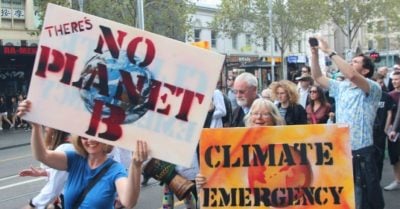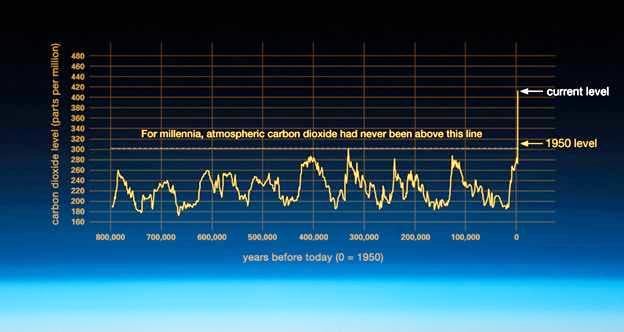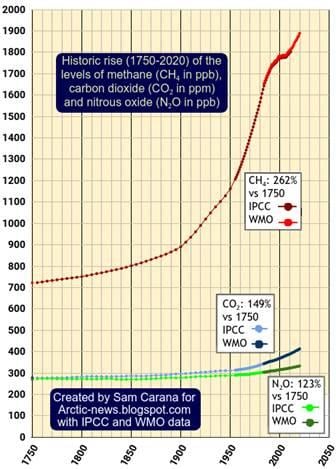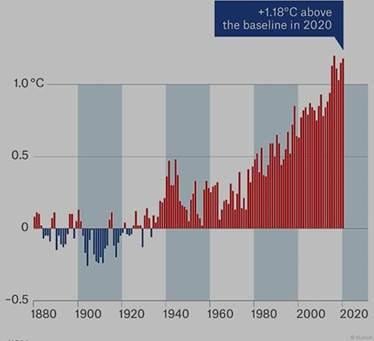Climate Change: Amplifying Feedbacks from Land and Ocean May Render Emission Reductions Insufficient

All Global Research articles can be read in 51 languages by activating the “Translate Website” drop down menu on the top banner of our home page (Desktop version).
Visit and follow us on Instagram at @crg_globalresearch.
***
While the world, for very good reasons, is relying on medical research in order to save the lives of millions, the “powers that be” are hardly listening to what climate science is saying about the existential threat to billions posed by global heating.
Since 1751 the world has emitted over 1.5 trillion tonnes of CO₂. The atmospheric level of CO₂ was 413.2 parts per million (ppm) in 2020, growing at peak rates of 2.5-3.0 ppm/year, representing the greatest acceleration since the dinosaur mass extinction of 66 million years ago.
“The last time the Earth experienced a comparable concentration of CO₂ was 3-5 million years ago, when the temperature was 2-3°C warmer and sea level was 10-20 meters higher than now”, Prof. Petteri Taalas, Secretary-General of the World Meteorological Organization said in a news release.
The rise of atmospheric greenhouse gases to levels >>400 ppm has the potential to rapidly transform the atmosphere into conditions similar to those of the Miocene and even the Eocene — a catastrophe for life on Earth.
Figure 1. Comparison of atmospheric samples contained in ice cores and more recent direct measurements, provides evidence that atmospheric CO₂ has increased since the Industrial Revolution. (Credit: NASA, data: Luthi, D., et al. 2008; Etheridge, D.M., et al. 2010; Vostok ice core data/J.R. Petit et al.; NOAA Mauna Loa CO2 record.)
Figure 2. Percent rises of CO2, CH4 and NO2 since 1750 (after Sam Carana)
According to the IPCC
“the effects of +1.5°C of warming (relative to mean pre-industrial temperature), plus the projection that half a degree Celsius, 2°C versus 1.5°C, will make quite a considerable difference in the livability of planet Earth […] the trajectory of warming based on historical trends will see increases certainly above 3°C and possibly much more if emissions aren’t cut […] the whole world must become carbon neutral by 2050.”
Figure 3. Global mean temperature deviation from 1880-1900: all 19 years since 2002 rank among the 20 warmest. (Image by Munichre.com based on NOAA data)
Average global temperatures may be misleading. According to NASA, “The impacts of climate change haven’t been spread evenly around our planet [..] The strongest warming is happening in the Arctic during its cool seasons, and in Earth’s mid-latitude regions during the warm season”. The reduced albedo of the melting polar ice sheets are driving global warming at a rate faster than elevated temperatures in the tropics.
While the focus of international policies is on the essential reduction in emissions, it is the cumulative effect of greenhouse gases in the atmosphere which drives global warming. The 2020 CO₂ level being 413.30 ppm, exceeding pre-industrial levels by more than 133 ppm. Unless civilization finds a way to down-draw CO₂ from the atmosphere, amplifying feedbacks from land and oceans will continue to heat the Earth, due to:
- The polar albedo (reflection) decline due to large-scale lateral and vertical melting of ice;
- Reduced CO₂ intake by the warming oceans. Currently the oceans absorb between 35-42 percent of all CO₂ emitted to the atmosphere and around 90 percent of the excess heat;
- Warming, desiccation, deforestation and fires over land areas;
- Release of methane from melting of permafrost and from polar sediments;
- An increase in evaporation, particularly in arid zones, raising atmospheric vapor levels which enhances the greenhouse gas effect.
These feedbacks result in an accelerated climate change, as projected by Wally Broecker and others, and potentially in mass extinction. A climate chain-reaction is believed to have pertained about 55 million years ago during the Paleocene-Eocene thermal maximum (PETM). According to Peter Ward and others, early examples of mass extinctions triggered by biological processes were related to ocean anoxia and acidification leading to methane (CH₄) and hydrogen sulfate (H₂S) release by “purple” and “green” algae and sulphur bacteria. In a similar sense anthropogenic global warming constitutes a geological/biological process for which the originating organism (sapiens) has not to date discovered an effective method of control.
Sequestration of CO₂ is essential due to the amplifying feedbacks of global warming, which are pushing temperatures up in a chain reaction-like process.
Whereas the aim of the Glasgow COP26 Conference is to reach agreement for limiting mean global temperature to <1.5°C, the short-term mitigating effect of aerosols on global temperatures, namely ~0.5 – 1.0°C, means global temperatures are already nearing ~2.0°C.
Hopes that the Glasgow climate meeting would help save the world from a climate catastrophe would depend on:
- Binding agreements for the most abrupt reduction of carbon emissions rates to pre-peak rates of about 1 ppm/year or lower, requiring a world-wide transformation of agricultural, industrial and transport systems;
- Attempts at sequestration/drawdown of greenhouse gases aimed at reducing the current atmospheric CO₂ levels to near-350 ppm or lower (Hansen et al. 2013). Whereas the engineering efforts and costs of such attempts cannot be overestimated, such could in principle be achieved by diversion from the astronomical budgets invested in defense industries, eventually aimed at future wars and further catastrophe.
The concept of a “carbon budget”, allowing the world to constrain emission to a particular amount of greenhouse gases in order to limit warming, does not take into account the amplifying feedbacks to warming from land and oceans, nor possible reversals due to the flow of cold water from melting ice sheets into the oceans.
The critical criterion definitive of global warming, namely the atmospheric concentration of greenhouse gases, rising by nearly ~50% since pre-industrial time, is only rarely mentioned. Nor are other quantitative measures of climate change, such as the level of methane and nitrous oxide, which have risen by about 3-fold being highlighted. While opinions by journalists, politicians, economists and social scientists proliferate, less attention is given to what is indicated by climate science. This reluctance renders the global response to the looming climate calamity increasingly irrelevant.
It is the ethical duty of scientists to advice governments and the public of dangerous developments, but it incurs a heavy price to pay for communicating worrying news Cassandra-like, including social and professional isolation. Don’t envy scientists aware of the ultimate consequences of global warming. Many have either self-censored or their work suppressed or dismissed within institutions and the media, including in governments and academia.
The reluctance of too many to undertake effective defense of the Earth’s climate, since nearly 40 years ago, can only culminate in devastation of the planet’s life support systems—one of the greatest catastrophes the planet has undergone since the dinosaur extinction about 66 million years ago.
*
Note to readers: Please click the share buttons above or below. Follow us on Instagram, @crg_globalresearch. Forward this article to your email lists. Crosspost on your blog site, internet forums. etc.
This article was originally published on Arctic News.
Dr Andrew Glikson is an Earth and Paleo-climate scientist, Canberra, Australia. He is a frequent contributor to Global Research.
Featured image: People hold signs during the March for Science in Melbourne, Australia on April 22, 2017. (Photo: Takver/flickr/ccc)




